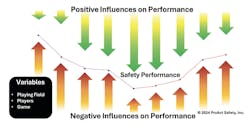Playing Field, Players and the Game: Understanding Safety Performance
Years after successfully improving safety for a mining organization, I was called back to investigate why their safety performance was declining. To illustrate the situation, I used a whiteboard to draw a curve that depicted the organization’s safety performance improving during the years we had worked together. We also highlighted all the positive actions the organization had taken to enhance safety.
However, the performance started heading in the wrong direction three years prior. Along the timeline, we listed all the changes at the location, such as changes in work procedures, significant increase in head count, decrease in operational knowledge, and changes in the client’s expectations and overall business environment. The new general manager, who had recently joined the organization, exclaimed, “Well, it’s no wonder why safety performance declined!”
Poor safety performance is often an indicator of deeper organizational issues. While these issues may become evident in safety incidents or accidents, they can also be observed in deviations from expected standards in quality, cost, schedule, delivery and other operational areas.
When safety performance takes a turn for the worse, it’s essential to pinpoint the factors contributing to the change. In my experience, three key variables are likely to have shifted: the playing field, the players and the game itself. Since the onset of the COVID-19 pandemic, organizations across the board have witnessed changes in one—or all—of these aspects.
Playing Field
First, an organization’s playing field is not a physical location or a set of plans. Instead, it represents the metaphorical space where employees interact with one another and external stakeholders.
The playing field encompasses how decisions are made, challenges are faced and goals are pursued within the organization. It sheds light on what is important and is observed in the actions of its members. Factors such as engagement, relationships, leadership, culture and external pressures all influence how and why people work. The playing field is dynamic and ever-changing. If it is healthy and mature, it fosters healthy competition, growth and collective achievements.
On an individual level, the playing field reveals how well employees know and perform their jobs, their attitudes toward work and how they interact with others. It serves as a reflection of their engagement or disengagement. Has anything on your playing field recently changed? How might that affect safety performance?
Players
The players on the field encompass all employees, from workers to managers to leaders. For an organization to excel, these individuals need to be highly engaged. This means they should be well-trained, equipped to achieve their goals, experienced enough to handle unexpected situations, and capable of interacting well with others. They should also genuinely care about each other and have a strong sense of shared ownership.
It is crucial to regularly assess players’ skills, engagement and potential to ensure they are in the right positions and have the necessary resources to excel. Have any of your players recently changed? How might that affect safety performance?
Game
The game is fairly straightforward: the specific objectives and strategies being pursued on the playing field, the business you are in, the products you produce and the services you provide. The game can change when production increases, customer requirements evolve and supply chain disruptions occur. These can also be coupled with investments in automation, company expansion or contraction, and new disruptive competitors. Has anything in your game changed recently? How might that affect safety performance?
Creating Sustainable Safety Excellence
How well do you know your field, players and the game? Leaders must deeply understand their game and have comprehensive knowledge of the field and the players. The best way to for leaders to learn this is by physically immersing themselves in the organization, observing and engaging with employees, and building relationships.
I encourage you to actively walk your field, keenly observe, and genuinely engage with your employees and internal customers. By immersing yourself in the game, you will truly understand the dynamics at play and be better equipped to monitor performance in real-time and proactively intervene prior to any deviations from expectations that could result in injuries or incidents.
About the Author
Shawn M. Galloway
CEO
Shawn M. Galloway is CEO of ProAct Safety, author of several books, including Shared Ownership: Engaging the Subcultures, and host of the podcast “Safety Culture Excellence.” As an award-winning consultant, adviser, leadership coach, and keynote speaker (including at EHS Today's Safety Leadership Conference), he has helped hundreds of organizations within every primary industry to improve safety strategy, culture, leadership, and engagement. For more information, call (936) 273-8700 or email [email protected].


